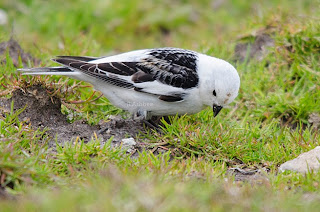see http://birdingfrontiers.com/
Snow Bunting showing characters of Siberian Snow Bunting ssp. vlasowae,apparently a 2cy (1st summer male) on Fetlar, early June 2013 photo by R. Ashbee . Richard photographed this bird in the field north of Loch Funzie. We were there, just never looked in that direction. Compare the upperparts with (below) this male Snow Bunting at Compass head which is a male has all white rump which means it is of the nominate form ‘nivalis‘. Male Icelandic Snow Buntings (ssp. insulae) have a dark centre to the rump.
Gulls are not everyone's favourite group of birds , they are tricky to identify especially when young. Gulls especially in Shetland are found all over the island as you would expect.
The Gt Black Backed Gull is one of the largest to be found in the UK, they are very aggressive both to human and bird alike but even so the eggs and young are predated by the Gt Skua. Some birds tend to be more solitary breeders than other gulls except those on stacks, close to other seabirds.
Is it a dog, is it a plane, no its a Gt BB Gull
Never seen the above before, GT BB carrying a bone, this was photographed on Burra.
Nest building starts in April with eggs laid the same month and the first chick can be found late May. Three eggs are normal and the adults are usually aggressive from this stage. Young are fed on a mixture of Sandeel and seabird meat especially Puffin and other Auks. Non breeders tend to feed on discards.
Any colonies are usually deserted by early August.
Numbers of these gulls are thought to be declining, on Noss numbers have dropped from 235 in 1973 to just 49 pairs in 2002, this coincided with increased predation by Gt Skuas as they struggled to find food for their young. In 2000 the last full count revealed around 2,200 pairs nesting in Shetland.
Local birds can be found in Shetland throughout the year and are augmented by birds from further north, especially following strong easterly winds when numbers of birds are blown in shore.
Have a look at my new blog on right
shetlandsky.blogspot.co.uk






































